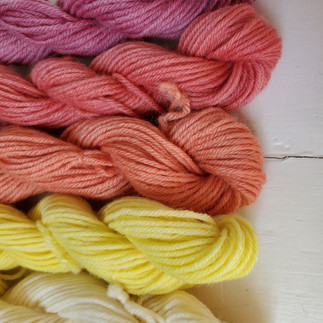Dyeing wool yarn with plants
- Stephanie Hubert
- 7 days ago
- 2 min read

Spring brings many changes. Using the plants around us to dye yarn is one traditional spring change. But how does a forsythia plant go from twig to yellow yarn?

Animal fibers, such as wool need a mordant, or binder to help the naturally occurring plant dyes stick to the wool fibers. Before the wool is placed in the plant dye liquid, it must be soaked in the mordant. What mordant and how much mordant are used depends on many things, such as the plant a person is using to dye and the pH of the water used.

Using different plants will help create different colors. Changing the pH of the mordant or dye bath will help create different end results.

Using plants to dye yarn is more complicated than using commercial chemical dyes, but it is environmentally friendly and safe. Any ingredient used to dye yarn at Rabbitry & Yarns must be safe enough to spill anywhere or on any being. It must also not caused harm if accidentally ingested. The used dye bath can be disposed of simply by emptying the pan into the grass.

Naturally dyeing yarn can be completely electricity-free. Although the pot of yarn in the image above is on the kitchen stove, it is simply soaking. No heat is applied. No electricity is needed. Time works just as well as electricity. It simply takes a little longer.

Dyeing with plants produces beautiful results. Please feel free to explore the naturally dyed yarns available at Rabbitry & Yarns...but they are selling fast!
Are you ready to try dyeing yarn naturally? Check out our affordable line of wool yarns!
.png)
_JPG.jpg)






Comments